(By Jared Hoyle, KSU Turfgrass Research and Extension)
Now that the summer weather is finally here it is time to start thinking about maintenance on warm-season turfgrass. Below are some monthly reminders for everyone that has warm-season turf.

Bermudagrass and Zoysiagrass
May – August 15
Fertilize with 1 lb. of nitrogen per 1,000 square feet per application. Follow the recommendations on the bag. More applications will give a deeper green color, but will increase mowing and may lead to thatch buildup with zoysiagrass. Bermudagrass can also have problems with thatch buildup but thatch is less likely with Bermuda than zoysia. Bermudagrass – Use two to four applications. Zoysiagrass – Use one to two applications. Too much nitrogen leads to thatch buildup.
One Application: Apply in June.
Two Applications: Apply May and July.
Three Applications: Apply May, June, and early August.
Four Applications: Apply May, June, July, and early August.
Remember to look and see if you are using a quick release nitrogen source or a slow release nitrogen source. If you use a quick release source then it is immediately available but only lasts a couple weeks. Thats why you would have to make a couple of applications like it is listed above. If you are going to use a slow release source it will tell you on the bag how long the product will last. Therefore, you might not have to make as many applications.
So generally you want to use a total of 2 to 4lb. of nitrogen per 1,000 square feet per year for bermudagrass and 1 to 2 lb. of nitrogen per 1,000 square feet per year for zoysiagrass.
June
If grubs have been a problem in the past, apply a product containing imidacloprid by mid July. Imidacloprid can be applied as early as mid May if there are problems with billbugs or May beetle grubs. These products kill the grubs before they cause damage. They are effective and safe but must be watered in before they become active. June is a good time to core aerate a warm-season lawn. Core aeration will help alleviate compaction, increase the rate of water infiltration, improve soil air exchange and help control thatch.
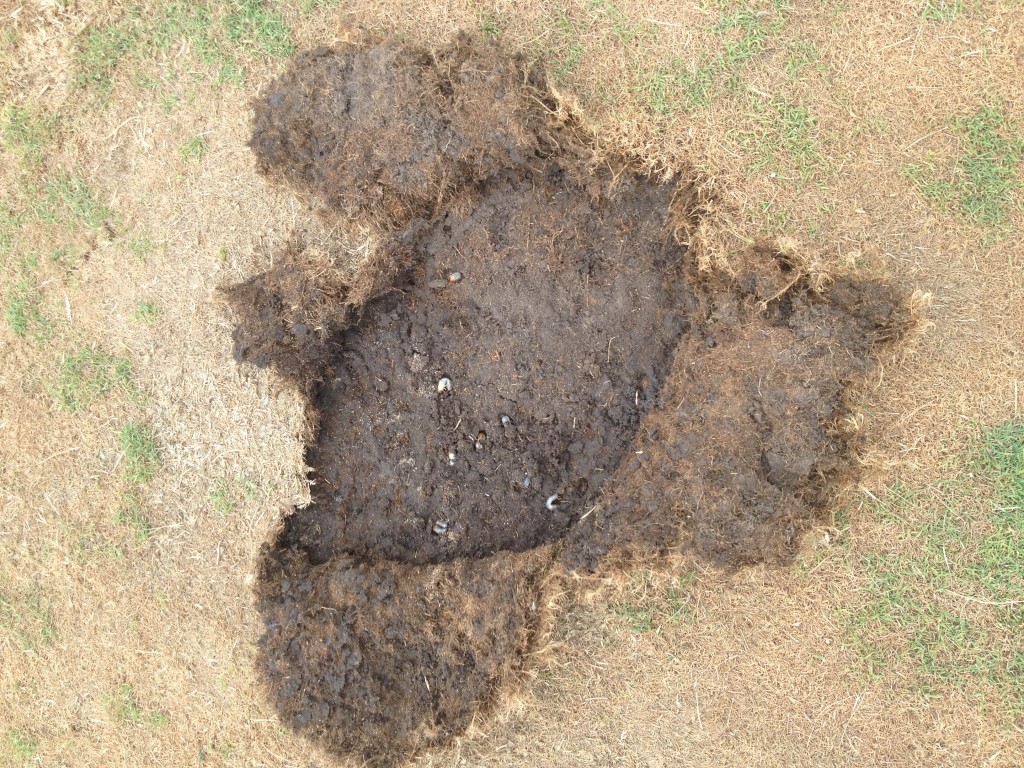
Late-July through August
If you see grub damage, apply a grub killer. If Imidacloprid has been applied, this should not be necessary. Grub killers must be watered in immediately.
For more information check out the Zoyisagrass Lawns Publication at the KSRE Bookstore – https://www.bookstore.ksre.ksu.edu/Item.aspx?catId=545&pubId=1451
For more information check out the Bermudagrass Lawns Publication at the KSRE Bookstore – https://www.bookstore.ksre.ksu.edu/Item.aspx?catId=545&pubId=586

Buffalograss
June
Fertilize with 1 lb. of nitrogen per 1,000 square feet during June. More applications will give a deeper green color, but can encourage weeds. If it is felt that a second application is needed, apply in July.
If grubs have been a problem in the past, apply a product containing imidacloprid by mid July. Imidacloprid can be applied as early as mid May if there are problems with billbugs or May beetle grubs. These products kill the grubs before they cause damage. They are effective and safe but must be watered in before they become active. Again, I would only treat if grubs have been a problem in the past. Note that the whole area may not need to be treated. The beetles that lay the eggs for the grubs are attracted to lights and moist soil and those areas are most likely to be infested.
Late-July through August
If you see grub damage, apply a grub killer. If imidacloprid has been applied or if grubs have not been a problem in the past, this should not be necessary. Grub killers must be watered in immediately.
For more information check out the Buffalograss Lawns Publication at the KSRE Bookstore – https://www.bookstore.ksre.ksu.edu/Item.aspx?catId=545&pubId=1447
Always remember to READ THE LABEL for the correct rate, turfgrass tolerance, and specific instructions before application!!!
***Mention of trade names or commercial products in this article is solely for identification purposes and does not imply recommendation or endorsement, nor is criticism implied of similar products not mentioned by Kansas State University.***
Don’t forget to follow me on twitter @KSUTurf.
Also, visit our facebook page www.facebook.com/KSUTurf
 our bird baths and water features, it is important to provide weekly maintenance to them. This includes emptying and changing out the water to remove potential mosquito habitats. If you happen to have a swimming pool, circulation of water and appropriate treatments are needed to eliminate mosquito habitats. In addition, avoid over-watering. As I was driving in Manhattan today, following a night of rain showers, I noticed someones sprinklers going off. The runoff and wet ground is only adding to this mosquito problem.
our bird baths and water features, it is important to provide weekly maintenance to them. This includes emptying and changing out the water to remove potential mosquito habitats. If you happen to have a swimming pool, circulation of water and appropriate treatments are needed to eliminate mosquito habitats. In addition, avoid over-watering. As I was driving in Manhattan today, following a night of rain showers, I noticed someones sprinklers going off. The runoff and wet ground is only adding to this mosquito problem.
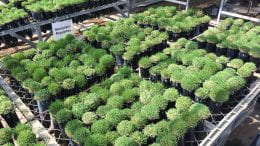



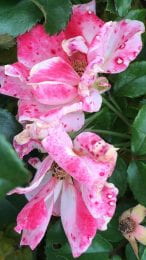
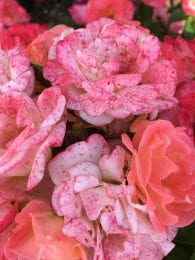
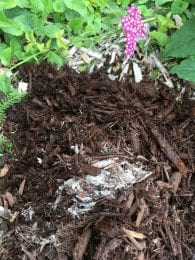 every spring. Basically mulch molds are wood decomposers. They occur as part of the natural ecosystem that breaks down organic matter. This is probably why we have to replace the mulch in our flower beds every year.
every spring. Basically mulch molds are wood decomposers. They occur as part of the natural ecosystem that breaks down organic matter. This is probably why we have to replace the mulch in our flower beds every year. It is not necessary to use fungicides to get rid of them. They are pretty much present whether we see them or not.
It is not necessary to use fungicides to get rid of them. They are pretty much present whether we see them or not.

 This fungal disease is primarily a problem on mature pine plantings (ie crowded, with poor air flow). Over a period of many years (10-15), the disease slowly chews up the tree resulting in a tree that appears half dead. The black pepper speck, fungal fruiting bodies (pycnidia) on the back of the pine cone scales are a key diagnostic feature for Diplodia tip blight.
This fungal disease is primarily a problem on mature pine plantings (ie crowded, with poor air flow). Over a period of many years (10-15), the disease slowly chews up the tree resulting in a tree that appears half dead. The black pepper speck, fungal fruiting bodies (pycnidia) on the back of the pine cone scales are a key diagnostic feature for Diplodia tip blight.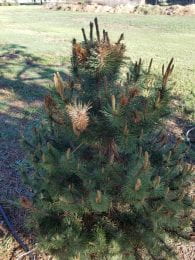 by two separate pine samples that came through the K-State Plant Disease Diagnostic lab last week. Both pines had Diplodia tip blight, causing a shoot blight of the new growth, but…they were from young trees (3-5yrs old)!
by two separate pine samples that came through the K-State Plant Disease Diagnostic lab last week. Both pines had Diplodia tip blight, causing a shoot blight of the new growth, but…they were from young trees (3-5yrs old)!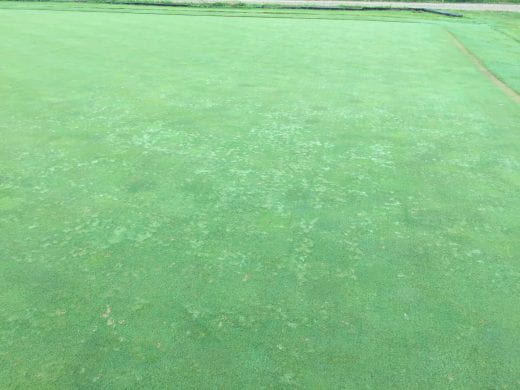



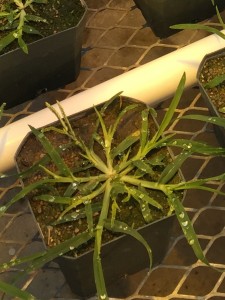

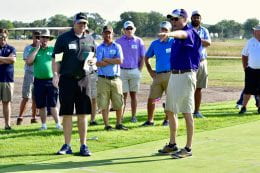 The field day program is designed for all segments of the turf & ornamentals industry – lawn care, athletic fields, golf courses, nursery, landscape & grounds maintenance. Included in the field day program: research presentations, problem diagnosis, commercial exhibitors, and equipment displays.
The field day program is designed for all segments of the turf & ornamentals industry – lawn care, athletic fields, golf courses, nursery, landscape & grounds maintenance. Included in the field day program: research presentations, problem diagnosis, commercial exhibitors, and equipment displays.
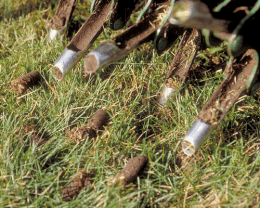 It should be neither too wet nor too dry, and the soil should crumble fairly easily when worked between your fingers. Go over the lawn enough times so that the aeration holes are about 2 inches apart.
It should be neither too wet nor too dry, and the soil should crumble fairly easily when worked between your fingers. Go over the lawn enough times so that the aeration holes are about 2 inches apart.